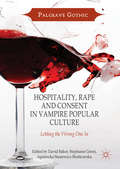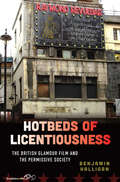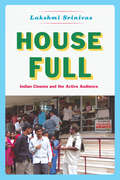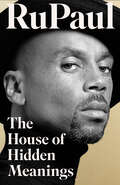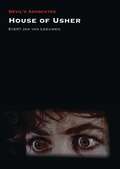- Table View
- List View
Hospitality, Rape and Consent in Vampire Popular Culture: Letting the Wrong One In (PDF)
by David Baker Stephanie Green Agnieszka Stasiewicz-BieńkowskaThis unique study explores the vampire as host and guest, captor and hostage: a perfect lover and force of seductive predation. From Dracula and Carmilla, to True Blood and The Originals, the figure of the vampire embodies taboos and desires about hospitality, rape and consent. The first section welcomes the reader into ominous spaces of home, examining the vampire through concepts of hospitality and power, the metaphor of threshold, and the blurred boundaries between visitation, invasion and confinement. Section two reflects upon the historical development of vampire narratives and the monster as oppressed, alienated Other. Section three discusses cultural anxieties of youth, (im)maturity, childhood agency, abuse and the age of consent. The final section addresses vampire as intimate partner, mapping boundaries between invitation, passion and coercion. With its fresh insight into vampire genre, this book will appeal to academics, students and general public alike.
Hospitality, Rape and Consent in Vampire Popular Culture: Letting the Wrong One In
by David Baker Stephanie Green Agnieszka Stasiewicz-BieńkowskaThis unique study explores the vampire as host and guest, captor and hostage: a perfect lover and force of seductive predation. From Dracula and Carmilla, to True Blood and The Originals, the figure of the vampire embodies taboos and desires about hospitality, rape and consent. The first section welcomes the reader into ominous spaces of home, examining the vampire through concepts of hospitality and power, the metaphor of threshold, and the blurred boundaries between visitation, invasion and confinement. Section two reflects upon the historical development of vampire narratives and the monster as oppressed, alienated Other. Section three discusses cultural anxieties of youth, (im)maturity, childhood agency, abuse and the age of consent. The final section addresses vampire as intimate partner, mapping boundaries between invitation, passion and coercion. With its fresh insight into vampire genre, this book will appeal to academics, students and general public alike.
Hot Flush: Motherhood, the Menopause and Me
by Michelle HeatonAt the age of thirty-three, Michelle Heaton, singer, TV presenter, star of the hit ITV show The Real Full Monty, mother and wife underwent a double mastectomy and hysterectomy to reduce the risk of cancer caused by the BRCA gene mutation. The journey that Michelle’s body embarked upon following the surgeries led her into the menopause in her mid-thirties.In Hot Flush, Michelle traces her path from pop stardom with Liberty X through her burgeoning television career and how she came to discover the truth about the gene mutation and its consequences for her. Though her story is undoubtedly unique, what’s not is her understanding of living and dealing with the menopause as a hardworking mother and wife, and it is this wisdom that she wants to share with other women – over 13 million women in the UK – estimated to be experiencing the menopause.Candid and honest, Hot Flush details Michelle’s struggles with dealing with the menopause in her own head as well as in her marriage, family life and the work place. She details the emotional and physical challenges she has faced – the explosive moods, the hot flushes and the mourning of the loss of a woman’s sex appeal. Along the way, she offers real help and advice on how to stay healthy in mind and body.Inspiring, raw and unfailingly honest, Hot Flush is a candid approach to introducing your body to its next chapter.
Hotbeds of Licentiousness: The British Glamour Film and the Permissive Society
by Benjamin HalliganHotbeds of Licentiousness is the first substantial critical engagement with British pornography on film across the 1970s, including the “Summer of Love,” the rise and fall of the Permissive Society, the arrival of Margaret Thatcher, and beyond. By focusing on a series of colorful filmmakers whose work, while omnipresent during the 1970s, now remains critically ignored, author Benjamin Halligan discusses pornography in terms of lifestyle aspirations and opportunities which point to radical changes in British society. In this way, pornography is approached as a crucial optic with which to consider recent cultural and social history.
Hotbeds of Licentiousness: The British Glamour Film and the Permissive Society
by Benjamin HalliganHotbeds of Licentiousness is the first substantial critical engagement with British pornography on film across the 1970s, including the “Summer of Love,” the rise and fall of the Permissive Society, the arrival of Margaret Thatcher, and beyond. By focusing on a series of colorful filmmakers whose work, while omnipresent during the 1970s, now remains critically ignored, author Benjamin Halligan discusses pornography in terms of lifestyle aspirations and opportunities which point to radical changes in British society. In this way, pornography is approached as a crucial optic with which to consider recent cultural and social history.
Hotbeds of Licentiousness: The British Glamour Film and the Permissive Society
by Benjamin HalliganHotbeds of Licentiousness is the first substantial critical engagement with British pornography on film across the 1970s, including the “Summer of Love,” the rise and fall of the Permissive Society, the arrival of Margaret Thatcher, and beyond. By focusing on a series of colorful filmmakers whose work, while omnipresent during the 1970s, now remains critically ignored, author Benjamin Halligan discusses pornography in terms of lifestyle aspirations and opportunities which point to radical changes in British society. In this way, pornography is approached as a crucial optic with which to consider recent cultural and social history.
Hotbeds of Licentiousness: The British Glamour Film and the Permissive Society
by Benjamin HalliganHotbeds of Licentiousness is the first substantial critical engagement with British pornography on film across the 1970s, including the “Summer of Love,” the rise and fall of the Permissive Society, the arrival of Margaret Thatcher, and beyond. By focusing on a series of colorful filmmakers whose work, while omnipresent during the 1970s, now remains critically ignored, author Benjamin Halligan discusses pornography in terms of lifestyle aspirations and opportunities which point to radical changes in British society. In this way, pornography is approached as a crucial optic with which to consider recent cultural and social history.
Hotbeds of Licentiousness: The British Glamour Film and the Permissive Society
by Benjamin HalliganHotbeds of Licentiousness is the first substantial critical engagement with British pornography on film across the 1970s, including the “Summer of Love,” the rise and fall of the Permissive Society, the arrival of Margaret Thatcher, and beyond. By focusing on a series of colorful filmmakers whose work, while omnipresent during the 1970s, now remains critically ignored, author Benjamin Halligan discusses pornography in terms of lifestyle aspirations and opportunities which point to radical changes in British society. In this way, pornography is approached as a crucial optic with which to consider recent cultural and social history.
Houdini: The Elusive American (Jewish Lives)
by Adam BegleyFrom the prizewinning Jewish Lives series, an exuberant biography of the world’s greatest escape artist In 1916, the war in Europe having prevented a tour abroad, Harry Houdini wrote a film treatment for a rollicking motion picture. Though the movie was never made, its title, "The Marvelous Adventures of Houdini: The Justly Celebrated Elusive American," provides a succinct summary of the Master Mystifier’s life. Born Erik Weisz in Budapest in 1874, Houdini grew up an impoverished Jewish immigrant in the Midwest and became world-famous thanks to talent, industry, and ferocious determination. He concealed as a matter of temperament and professional ethics the secrets of his sensational success. Nobody knows how Houdini performed some of his dazzling, death-defying tricks, and nobody knows, finally, why he felt compelled to punish and imprison himself over and over again. Must a self-liberator also be a self-torturer? Tracking the restless Houdini’s wide-ranging exploits, acclaimed biographer Adam Begley asks the essential question: What kind of man was this?About Jewish Lives: Jewish Lives is a prizewinning series of interpretative biography designed to explore the many facets of Jewish identity. Individual volumes illuminate the imprint of Jewish figures upon literature, religion, philosophy, politics, cultural and economic life, and the arts and sciences. Subjects are paired with authors to elicit lively, deeply informed books that explore the range and depth of the Jewish experience from antiquity to the present. In 2014, the Jewish Book Council named Jewish Lives the winner of its Jewish Book of the Year Award, the first series ever to receive this award.More praise for Jewish Lives: "Excellent." – New York times "Exemplary." – Wall St. Journal "Distinguished." – New Yorker "Superb." – The Guardian
House: Jungian and Post-Jungian Reflections
by Luke Hockley Leslie GardnerHouse MD is a globally successful and long-running medical drama. House: The Wounded Healer on Television employs a Jungian perspective to examine the psychological construction of the series and its namesake, Dr Gregory House. The book also investigates the extent to which the continued popularity of House MD has to do with its representation of deeply embedded cultural concerns. It is divided into three parts - Diagnosing House, Consulting House and Dissecting House, - and topics of discussion include: specific details, themes, motifs and tropes throughout the series narrative, character and visual structure the combination of performative effects, text and images of the doctor and his team the activities of the hero, the wounded healer and the puer aeternus. Offering an entirely fresh perspective on House MD, with contributions from medical professionals, academics and therapists, this book is essential reading for students and scholars of Jungian psychology. The inclusion of a glossary of Jungian terms means that this book can also be enjoyed by fans of House MD who have been seeking a more in-depth analysis of the series.
House: Jungian and Post-Jungian Reflections
by Luke Hockley Leslie GardnerHouse MD is a globally successful and long-running medical drama. House: The Wounded Healer on Television employs a Jungian perspective to examine the psychological construction of the series and its namesake, Dr Gregory House. The book also investigates the extent to which the continued popularity of House MD has to do with its representation of deeply embedded cultural concerns. It is divided into three parts - Diagnosing House, Consulting House and Dissecting House, - and topics of discussion include: specific details, themes, motifs and tropes throughout the series narrative, character and visual structure the combination of performative effects, text and images of the doctor and his team the activities of the hero, the wounded healer and the puer aeternus. Offering an entirely fresh perspective on House MD, with contributions from medical professionals, academics and therapists, this book is essential reading for students and scholars of Jungian psychology. The inclusion of a glossary of Jungian terms means that this book can also be enjoyed by fans of House MD who have been seeking a more in-depth analysis of the series.
House Full: Indian Cinema and the Active Audience (Fieldwork Encounters and Discoveries)
by Lakshmi SrinivasIndia is the largest producer and consumer of feature films in the world, far outstripping Hollywood in the number of movies released and tickets sold every year. Cinema quite simply dominates Indian popular culture, and has for many decades exerted an influence that extends from clothing trends to music tastes to everyday conversations, which are peppered with dialogue quotes. With House Full, Lakshmi Srinivas takes readers deep into the moviegoing experience in India, showing us what it’s actually like to line up for a hot ticket and see a movie in a jam-packed theater with more than a thousand seats. Building her account on countless trips to the cinema and hundreds of hours of conversation with film audiences, fans, and industry insiders, Srinivas brings the moviegoing experience to life, revealing a kind of audience that, far from passively consuming the images on the screen, is actively engaged with them. People talk, shout, whistle, cheer; others sing along, mimic, or dance; at times audiences even bring some of the ritual practices of Hindu worship into the cinema, propitiating the stars onscreen with incense and camphor. The picture Srinivas paints of Indian filmgoing is immersive, fascinating, and deeply empathetic, giving us an unprecedented understanding of the audience’s lived experience—an aspect of Indian film studies that has been largely overlooked.
House Full: Indian Cinema and the Active Audience (Fieldwork Encounters and Discoveries)
by Lakshmi SrinivasIndia is the largest producer and consumer of feature films in the world, far outstripping Hollywood in the number of movies released and tickets sold every year. Cinema quite simply dominates Indian popular culture, and has for many decades exerted an influence that extends from clothing trends to music tastes to everyday conversations, which are peppered with dialogue quotes. With House Full, Lakshmi Srinivas takes readers deep into the moviegoing experience in India, showing us what it’s actually like to line up for a hot ticket and see a movie in a jam-packed theater with more than a thousand seats. Building her account on countless trips to the cinema and hundreds of hours of conversation with film audiences, fans, and industry insiders, Srinivas brings the moviegoing experience to life, revealing a kind of audience that, far from passively consuming the images on the screen, is actively engaged with them. People talk, shout, whistle, cheer; others sing along, mimic, or dance; at times audiences even bring some of the ritual practices of Hindu worship into the cinema, propitiating the stars onscreen with incense and camphor. The picture Srinivas paints of Indian filmgoing is immersive, fascinating, and deeply empathetic, giving us an unprecedented understanding of the audience’s lived experience—an aspect of Indian film studies that has been largely overlooked.
House Full: Indian Cinema and the Active Audience (Fieldwork Encounters and Discoveries)
by Lakshmi SrinivasIndia is the largest producer and consumer of feature films in the world, far outstripping Hollywood in the number of movies released and tickets sold every year. Cinema quite simply dominates Indian popular culture, and has for many decades exerted an influence that extends from clothing trends to music tastes to everyday conversations, which are peppered with dialogue quotes. With House Full, Lakshmi Srinivas takes readers deep into the moviegoing experience in India, showing us what it’s actually like to line up for a hot ticket and see a movie in a jam-packed theater with more than a thousand seats. Building her account on countless trips to the cinema and hundreds of hours of conversation with film audiences, fans, and industry insiders, Srinivas brings the moviegoing experience to life, revealing a kind of audience that, far from passively consuming the images on the screen, is actively engaged with them. People talk, shout, whistle, cheer; others sing along, mimic, or dance; at times audiences even bring some of the ritual practices of Hindu worship into the cinema, propitiating the stars onscreen with incense and camphor. The picture Srinivas paints of Indian filmgoing is immersive, fascinating, and deeply empathetic, giving us an unprecedented understanding of the audience’s lived experience—an aspect of Indian film studies that has been largely overlooked.
House Full: Indian Cinema and the Active Audience (Fieldwork Encounters and Discoveries)
by Lakshmi SrinivasIndia is the largest producer and consumer of feature films in the world, far outstripping Hollywood in the number of movies released and tickets sold every year. Cinema quite simply dominates Indian popular culture, and has for many decades exerted an influence that extends from clothing trends to music tastes to everyday conversations, which are peppered with dialogue quotes. With House Full, Lakshmi Srinivas takes readers deep into the moviegoing experience in India, showing us what it’s actually like to line up for a hot ticket and see a movie in a jam-packed theater with more than a thousand seats. Building her account on countless trips to the cinema and hundreds of hours of conversation with film audiences, fans, and industry insiders, Srinivas brings the moviegoing experience to life, revealing a kind of audience that, far from passively consuming the images on the screen, is actively engaged with them. People talk, shout, whistle, cheer; others sing along, mimic, or dance; at times audiences even bring some of the ritual practices of Hindu worship into the cinema, propitiating the stars onscreen with incense and camphor. The picture Srinivas paints of Indian filmgoing is immersive, fascinating, and deeply empathetic, giving us an unprecedented understanding of the audience’s lived experience—an aspect of Indian film studies that has been largely overlooked.
House Full: Indian Cinema and the Active Audience (Fieldwork Encounters and Discoveries)
by Lakshmi SrinivasIndia is the largest producer and consumer of feature films in the world, far outstripping Hollywood in the number of movies released and tickets sold every year. Cinema quite simply dominates Indian popular culture, and has for many decades exerted an influence that extends from clothing trends to music tastes to everyday conversations, which are peppered with dialogue quotes. With House Full, Lakshmi Srinivas takes readers deep into the moviegoing experience in India, showing us what it’s actually like to line up for a hot ticket and see a movie in a jam-packed theater with more than a thousand seats. Building her account on countless trips to the cinema and hundreds of hours of conversation with film audiences, fans, and industry insiders, Srinivas brings the moviegoing experience to life, revealing a kind of audience that, far from passively consuming the images on the screen, is actively engaged with them. People talk, shout, whistle, cheer; others sing along, mimic, or dance; at times audiences even bring some of the ritual practices of Hindu worship into the cinema, propitiating the stars onscreen with incense and camphor. The picture Srinivas paints of Indian filmgoing is immersive, fascinating, and deeply empathetic, giving us an unprecedented understanding of the audience’s lived experience—an aspect of Indian film studies that has been largely overlooked.
House Full: Indian Cinema and the Active Audience (Fieldwork Encounters and Discoveries)
by Lakshmi SrinivasIndia is the largest producer and consumer of feature films in the world, far outstripping Hollywood in the number of movies released and tickets sold every year. Cinema quite simply dominates Indian popular culture, and has for many decades exerted an influence that extends from clothing trends to music tastes to everyday conversations, which are peppered with dialogue quotes. With House Full, Lakshmi Srinivas takes readers deep into the moviegoing experience in India, showing us what it’s actually like to line up for a hot ticket and see a movie in a jam-packed theater with more than a thousand seats. Building her account on countless trips to the cinema and hundreds of hours of conversation with film audiences, fans, and industry insiders, Srinivas brings the moviegoing experience to life, revealing a kind of audience that, far from passively consuming the images on the screen, is actively engaged with them. People talk, shout, whistle, cheer; others sing along, mimic, or dance; at times audiences even bring some of the ritual practices of Hindu worship into the cinema, propitiating the stars onscreen with incense and camphor. The picture Srinivas paints of Indian filmgoing is immersive, fascinating, and deeply empathetic, giving us an unprecedented understanding of the audience’s lived experience—an aspect of Indian film studies that has been largely overlooked.
The House of Beckham: Money, Sex and Power
by null Tom BowerThe explosive new book from Britain’s leading investigative biographer, Tom Bower As one of the most famous and influential couples in the world, David and Victoria Beckham have attained iconic status. The ultimate power couple have together built a multi-billion-dollar global brand. For decades, adoring fans have been captivated by the glamorous world they have created, while their unrivalled fusion of showbiz, fashion, football and celebrity has been cultivated alongside the image of a strong marriage. When the much-trailed Netflix documentary Beckham aired in 2023, viewers were offered an even more intimate insight into their private lives. Produced by the Beckhams themselves, the series raised many questions, not only about their success and personal relationship, but also about the ruthlessly successful management of their image in the media. Are their lives really as perfect as the Beckhams would like the world to believe? Through extensive research, expert sourcing and interviews with insiders, Britain’s most celebrated investigative biographer, Tom Bower, has unearthed a succession of revelations that give surprising insight into the reality of ‘Brand Beckham’. Exploring the couple’s relationship, and the truth about their football and fashion careers, their finances and their new life in Miami, The House of Beckham unravels the extraordinary reality of the business-savvy cultural icons to tell an engrossing, often astonishing story of money, sex and power.
House of Games: Question Smash: 104 New, Classic and Fiendishly Difficult Rounds
by Alan ConnorDo you know which Cluedo character was killed off in 2016? How about which band has a species of shrimp named after it? Reckon you could guess the name of a song from lyrics where the words have been replaced with synonyms?Then fingers on buzzers, because House of Games is back and it's better than ever!Packed with 104 new, classic and fiendishly difficult rounds from the hit BBC show's question writers, House of Games: Question Smash is the ultimate collection of brainteasers, puzzles and trivia. Pit your wits against friends and family with favourites like Highbrow Lowbrow, Rhyme Time and Don't State the Obvious, as well as brand new games from the brilliant minds behind the show. So limber up your frontal lobes, brush up on your trivia and get ready to return to the House of Games.
House of Games (Oberon Modern Plays)
by David Mamet Richard BeanIn a new adaptation of David Mamet’s film, Harvard-educated psychoanalyst Margaret Ford is celebrated for her best selling book ‘Driven! Compulsion and Obsession in Every Day Life’. Stepping in to help one of her patients settle his gambling debts, she compromises her professional reputation and is drawn into the seedy underworld of the House of Games poker club. Seduced by charismatic hustler Mike, Margaret convinces herself that she can make an academic study of the con. Before she realises it, Margaret is entangled in a fast-paced complex thriller.
The House of Hidden Meanings: A Memoir
by RuPaulFrom international drag superstar and pop culture icon RuPaul, comes his most revealing and personal work to date—a brutally honest, surprisingly poignant, and deeply intimate memoir of growing up Black, poor, and queer in a broken home to discovering the power of performance, found family, and self-acceptance.
House of Usher (Devil's Advocates)
by Evert van LeeuwenDespite being the product of Roger Corman’s AIP exploitation studio, House of Usher enjoys a high standing. But while the impact and cult status of Corman’s Edgar Allan Poe cycle is often discussed in histories of gothic, horror, and exploitation cinema, no extended analysis and critical discussion has been published to date that explores specifically the aesthetic appeal of House of Usher. This Devil’s Advocate provides a complete study of the aesthetic appeal of Corman’s influential first Poe picture.Evert van Leeuwen explores the underlying narrative structure borrowed from Poe’s original story and shows how closely Richard Matheson’s script followed Poe’s theory of short fiction. He goes on to explore the formal techniques of allegory and symbolism employed to represent the house as a monster before focusing on Corman’s imagery, showing how the use of specific camera angles, lenses, colors, and sound effects create and sustain the simultaneously morbid and beautiful atmosphere of gothic decay. Finally, he situates horror icon Vincent Price’s performance as Roderick Usher in the context of the nineteenth-century Romantic misfit and the postwar countercultural antihero, two closely related cultural identities.
House of Usher (Devil's Advocates)
by Evert van LeeuwenDespite being the product of Roger Corman’s AIP exploitation studio, House of Usher enjoys a high standing. But while the impact and cult status of Corman’s Edgar Allan Poe cycle is often discussed in histories of gothic, horror, and exploitation cinema, no extended analysis and critical discussion has been published to date that explores specifically the aesthetic appeal of House of Usher. This Devil’s Advocate provides a complete study of the aesthetic appeal of Corman’s influential first Poe picture.Evert van Leeuwen explores the underlying narrative structure borrowed from Poe’s original story and shows how closely Richard Matheson’s script followed Poe’s theory of short fiction. He goes on to explore the formal techniques of allegory and symbolism employed to represent the house as a monster before focusing on Corman’s imagery, showing how the use of specific camera angles, lenses, colors, and sound effects create and sustain the simultaneously morbid and beautiful atmosphere of gothic decay. Finally, he situates horror icon Vincent Price’s performance as Roderick Usher in the context of the nineteenth-century Romantic misfit and the postwar countercultural antihero, two closely related cultural identities.
A House Unlocked (Isis Series)
by Penelope LivelyA House Unlocked is Booker Prize winning author Penelope Lively's classic memoir.The only child of divorced parents, Penelope Lively was often sent to stay at her grandparents' country house Golsoncott. Years later, as the house was sold out of the family, she began to piece together the lives of those she knew fifty years before.In a needlework sampler, she sees her grandmother and the wartime children that she sheltered under her roof in 1940. Potted meat jars remind her of the ritual of doing the flowers for church. The smell of the harness room brings her Aunt Rachel - avant-garde artist, fervent horserider - vividly back to life.In A House Unlocked, Penelope Lively delves into the domestic past of her former home, and tells of her own youth and the contrasts between life today and the way they lived then.'Wonderful. Lively is brilliant and original . . . Every page of this book captures your attention' Daily Mail'Remarkable, richly enjoyable . . . a captivating memoir' Helen Dunmore, The Times'Engaging, curious, compelling, remarkable . . . Any time spent with Penelope Lively is a joy' ObserverPenelope Lively is the author of many prize-winning novels and short-story collections for both adults and children. She has twice been shortlisted for the Booker Prize: once in 1977 for her first novel, The Road to Lichfield, and again in 1984 for According to Mark. She later won the 1987 Booker Prize for her highly acclaimed novel Moon Tiger. Her other books include Going Back; Judgement Day; Next to Nature, Art; Perfect Happiness; Passing On; City of the Mind; Cleopatra's Sister; Heat Wave; Beyond the Blue Mountains, a collection of short stories; Oleander, Jacaranda, a memoir of her childhood days in Egypt; Spiderweb; her autobiographical work, A House Unlocked; The Photograph; Making It Up; Consequences; Family Album, which was shortlisted for the 2009 Costa Novel Award, and How It All Began. She is a popular writer for children and has won both the Carnegie Medal and the Whitbread Award. She was appointed CBE in the 2001 New Year's Honours List, and DBE in 2012. Penelope Lively lives in London.
Housework and Housewives in American Advertising: Married to the Mop
by Jessamyn NeuhausAn analysis of how since the end of te 19th-century advertising agencies and their housework product clients utilized a remarkably consistent depiction of housewives and housework, illustrating that that although Second Wave feminism successfully called into question the housewife stereotype, homemaking has remained an American feminine ideal.
